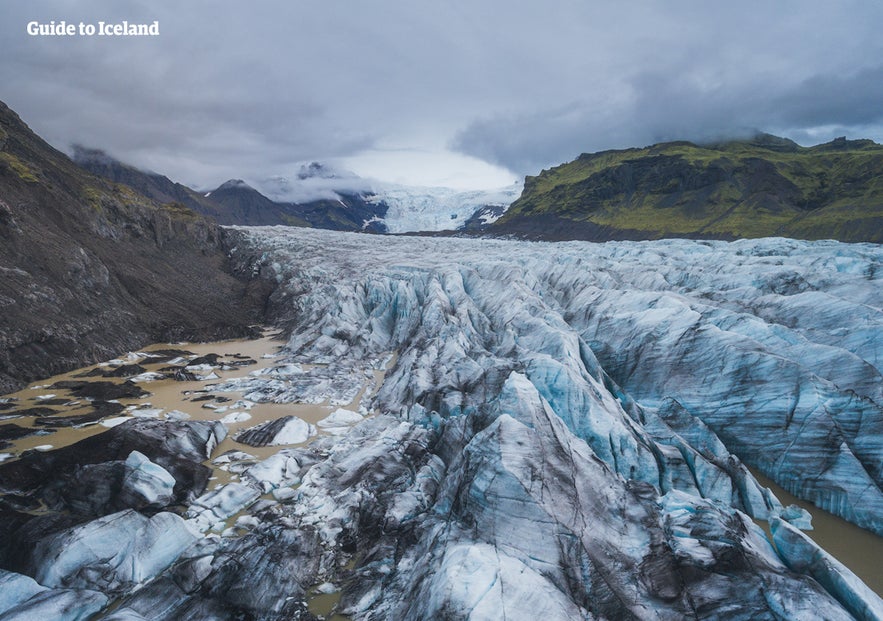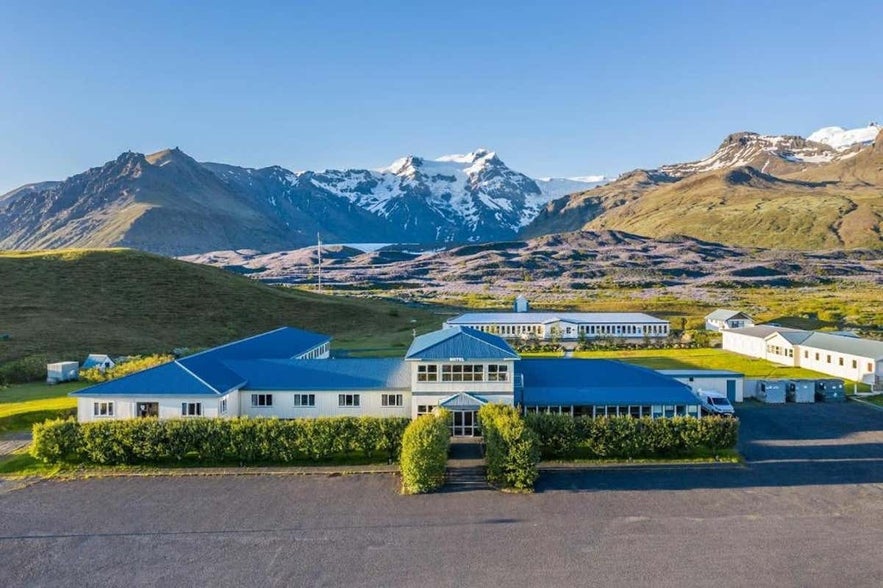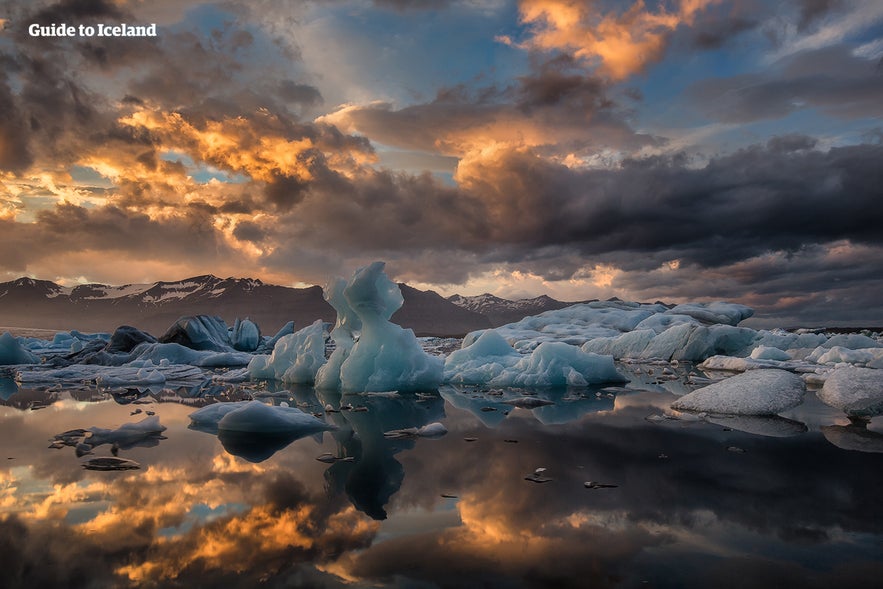Vatnajokullin jäätikkö, Vatnajökull islantilaisittain, on Euroopan suurin jäätikkö, peittäen alleen kahdeksen prosenttia Islannin mantereesta.
Valtavan kokonsa vuoksi, sen monilla alueilla usein vieraillaan osana monia omatoimisia automatkoja, opastetuja pakettimatkoja sekä etelärannikon retkiä. Esimerkiksi tämä 10 päivän kesäinen omatoiminen roadtrip ja tämä 6 päivän kesälomapaketti tarjoavat mahdollisuuden vierailla yksillä sen monista alueista. Jos vuokraat auton Islannissa, voit myös lähteä tutkimaan sitä.
Miksi sisältöömme voi luottaa
Guide to Iceland on Islannin luotetuin matkailusivusto ja auttaa vuosittain miljoonia matkailijoita. Kaikki sisältömme on paikallisten asiantuntijoiden kirjoittamaa ja tarkastamaa – he tuntevat Islannin läpikotaisin. Voit luottaa siihen, että saat meiltä ajankohtaista, paikkansapitävää ja luotettavaa matkailutietoa.
Jäätikkö on Lounais-Islannissa sijaitsevan Vatnajokullin kansallispuiston keskeinen osa. Tämä luonnonpuisto on kaunis ja suosittu alue aktiviteetteille, kuten jäätikkövaellukselle Skaftafellistä, veneretkille Jokulsarlonin jäätikkölaguunilla ja jääluolaretkille marras-maaliskuussa.
Faktoja Vatnajokullin jäätiköstä
Vatnajokullin jäätikön pinta-ala on noin 8100 neliökilometriä. Vaikka se kutistuu nopeasti ilmastonmuutoksen vuoksi, se ei ole vetäytynyt aivan niin pitkälle kuin muut jäätiköt, kuten Langjokull ja Myrdalsjokull.
Paikoin jäätikkö ulottuu yli kilometrin pituudelle, ja sen keskimääräinen paksuus on noin puolet siitä.
Vatnajokullin alla on myös Islannin korkein vuori. Hvannadalshnjukur on 2 200 metriä korkea. Jäätikkö kätkee alleen myös joitain maan aktiivisimmista tulivuorista, joista merkittävimmät ovat Grimsvotn, Oraefajokull ja Bardarbunga.
Alueella on esiintynyt runaasti vulkaanista aktiivisuutta jaksottain vuosisatojen ajan, ja monet geologit uskovatkin useiden purkauksien olevan myöhässä. Jos laskelmat ovat oikeassa, se merkitsisi merkittävää vulkaanista aktiivisuutta Vatnajokullin alueella seuraavan puolen vuosisadan aikana.
Bardarbunga ja Grimsvotn ovat molemmat purkautuneet 2000-luvulla.
Tuulista riippuen muut tulivuoret voivat aiheuttaa maailmanlaajuisia seuraamuksia lentoliikenteelle, maataloudelle ja ilmastolle noin yleensä, kuten Eyjafjallajökullin purkaus teki vuonna 2010.
Jäätiköllä on yli 30 ulostulojäätikköä — eli jääkanavaa, jotka virtaavat ulos jääpeitteestä pysytellen laakson sivuilla.
Vatnajokullin suurimpia jäätiköitä ovat Dyngjujokull pohjoisessa, Breidamerkurjokull ja Skeidararjokull etelässä. Lännessä sijaitsevat jäätiköt Sidujokull, Skaftarjokull ja Tungnaarjokull.
Vatnajokull-jäätiköstä virtaa lukuisia jokia, jotka muodostavat eräitä Islannin suurimmista jäätikköjoista. Merkittävimpiä ovat:
-
Tungna (länsi)
-
Koldukvisl (länsi)
-
Thjorsa (länsi)
-
Jokulsa a Fjollum (pohjoinen)
-
Skjalfandafljot (pohjoinen)
-
Jokulsa a Bru (koillinen)
-
Jokulsa i Fljotsdal (koillinen)
-
Jokulsa i Loni (etelä)
-
Hornafjardarfljot (etelä)
-
Jokulsa a Breidamerkursandi (etelä)
-
Skeidara (etelä)
-
Nupsvotn (etelä)
-
Hverfisfljot (etelä)
-
Skafa (etelä)
Vatnajokullin kansallispuisto
Vatnajokullin kansallispuisto perustettiin kesäkuussa 2008, ja se on hiljalleen kasvanut kattamaan lisää maa-alueita. Puiston pinta-ala on nyt 14 141 neliökilometriä, mikä on 14 prosenttia maan kokonaispinta-alasta. Se on Euroopan toiseksi suurin kansallispuisto ja yksi Islannin kolmesta Unescon maailmanperintökohteesta.
Se koostuu useammasta pienemmästä alueesta, jotka olivat aiemmin itsenäisiä kansallispuistoja — kuten Skaftafell — ja alueita, jotka ovat viime aikoina päätyneet suojelun piiriin, kuten Jokulsarlon.
Joet jakavat ylängön tasangon puiston pohjoispuolella. Tämän alueen yläpuolella kohoaa tulivuoren pöytävuori Herdubreid sekä tulivuoret Askja, Snaefell ja Kverkfjoll.
Jokulsargljufurin kanjoni muodostui jäätikön tulvista vuosisatoja sitten. Kanjonin yläpäästä löydät Dettifossin, Euroopan voimakkaimman vesiputouksen. Tätä uskomatonta putousta kehystävät kaksi muuta vesiputousta, Selfoss ja Hafragilsfoss.
Pohjoisempana, hevosenkengän muotoisen kanjonin, Asbyrgin uskotaan muodostuneen, kun Odinin kahdeksanjalkainen hevonen Sleipnir laski jalkansa maalle taivaasta.
Idässä Snaefellin ympärillä on kosteikkoja ja vuoristoalueita, joissa asuu vaeltavia villipeuralaumoja ja runsaasti erilaisia lintuja. Jyrkät vuorenharjat muodostavat Vatnajokullin eteläpuolen, jossa jäätiköt vyöryvät alamaille. Skeidararsandurin hiekkatasangot sijaitsevat myös etelässä, ja jäätikköjoki Skeidara virtaa tämän laajan aavikon läpi.
Yksi Islannin suosituimmista maamerkeistä kansallispuistossa on Jökulsárlónin jäätikkölaguuni, joka sijaitsee Breidamerkurjokull-jäätikön pohjalla. Täällä jäätikköstä irtautuneet suuret jäävuoret kelluvat suuren järven poikki ennen kuin päätyvät Atlantin valtamereen tai huuhtoutuvat rantaan läheisellä Timanttirannalla.
Tämä on yksi maan parhaista hylkeiden katselupaikoista.
Vatnajokullin tulevaisuus

Vatnajokullin koko saavutti huippunsa vuoden 1930 tienoilla, mutta on siitä lähtien ollut tasaisessa laskussa. Maapallon lämpötilan nousun vuoksi Vatnajokull on menettänyt paksuudestaan noin metrin vuosittain viimeisen 15 vuoden aikana.
Jos lämpötilat jatkavat nousuaan, jäätikkö saattaa olla lähes kokonaan sula seuraavan vuosisadan lopulla, jolloin korkeimpien vuorten huipulle jää vain pieniä jääpeitteitä.
Joidenkin mielestä väistämätöntä katoa pyritään estämään, ja jäätikön ympärillä onkin meneillään useita metsänistutushankkeita, mikä on hyväksi havaittu tapa jäähdyttää aluetta. Vain aika näyttää kuinka projektit menestyvät.
Vatnajokullja Jokulsarlon populaarikulttuurissa
Vatnajokullin kansallispuiston kauneus ei ole jäänyt huomaamatta elokuvissa tai televisiossa. Alueella on kuvattu monia kuuluisia kohtauksia, alkaen 007 ja kuoleman katse vuonna 1985. Muita merkittäviä elokuvia, jonka kohtauksia on kuvattu jäätiköllä ovat Batman Begins, Lara Croft: Tomb Raider, The Secret Life of Walter Mitty ja 007 — Kuolema saa odottaa. Dettifossin vesiputous oli esillä Prometheuksessa.
Tunnetuin fakta lienee kuitenkin se, ett' monia paikkoja Vatnajokullin alueella on käytetty HBO-sarjan Game of Thronesissa kohtauksissa "muurin pohjoispuolella". Itse muuri on rakennettu CGI:llä käyttämäen jäätiköstä otettuja kuvia.
Miten päästä Vatnajokullille
Vatnajokullin jäätikölle pääsee helposti vuokra-autolla Reykjavikista pitkin etelärannikkoa. Skaftafell, jossa on useita jäätikkövaelluspaikkoja, sijaitsee 327 kilometrin päässä pääkaupungista, ja monet sen jäätikön kielet ovat nähtävissä rengastien varrella.
Vatnajokullin kansallispuiston tärkeimmät kohteet, kuten Jokulsarlonin jäätikkölaguuni, Dettifossin vesiputous ja Asbyrgin kanjoni, ovat kaikki tämän tien varrella tai lyhyen ajomatkan päässä tästä tiestä, joka tunnetaan myös nimellä Tie 1.
Missä majoittautua Vatnajokull-jäätikön lähellä

Jos aiot tutustua Vatnajokull-jäätiköön, alueella on loistavia majoitusvaihtoehtoja. Mikäli aiot yöpyä lähellä Skaftafellin kansallispuistoa, Hotel Skaftafell on erinomainen valinta, ja se tarjoaa viihtyisiä huoneita, joista on upeat näkymät jäätikölle. Se on täydellinen tukikohta seikkailuille kansallispuistossa, ja paikan päällä on ravintola, jossa voit rentoutua tutkimusmatkasi jälkeen.
Guesthouse Skalafell tarjoaa viihtyisämmän ja intiimimmän kokemuksen. Tämä viehättävä majatalo tarjoaa lämpimän ilmapiirin ja luonnonkauniin ympäristön, joten se on rauhallinen lepopaikka jäätiköllä vierailun jälkeen.
Voit myös yöpyä Kirkjubaejarklausturissa, joka on tunnin ajomatkan päässä Skaftafellistä. Kauempana itään voit majoittautua Hofnissa, joka on tunnin ajomatkan päässä Jokulsarlonin jäätikkölaguunista.











